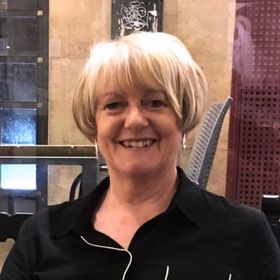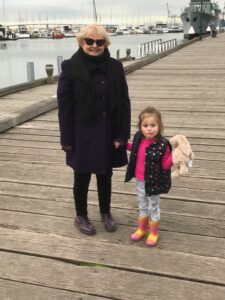“I Choose to Live”: Cathy Beesey’s Journey Through Vasculitis
From her home in Melbourne, Australia, Cathy Beesey is finding her way forward — step by step, word by word. Cathy, 67, was diagnosed with granulomatosis with polyangiitis (GPA), a rare form of vasculitis, at the age of 61. Her journey has not only shaped her health and relationships but inspired her to begin a journal, connect, and ultimately share her story with others navigating life with a chronic illness.

“I choose to live and love with dignity, learn with curiosity, and contribute with passion,” Cathy wrote in the conclusion to her memoir—a sentence that encapsulates both her outlook and resilience. “I choose to not let this autoimmune disorder define me, my life. It has taken six long years for this clarity to reveal itself.”
For Cathy, the symptoms crept in quietly: a nagging cough, fatigue that lingered for nearly a year, difficulty hearing and pain in her ears. By late 2018, she was struggling to breathe deeply and discovered blood in her urine. Though she saw a specialist—an ENT for her ears, her general practitioner (GP) for her lungs—her symptoms were treated separately until a moment of exasperation brought clarity. “I said to my GP, ‘I can’t cope with both my ears and lungs – can you fix one of them?’ That’s when he said there must be an underlying issue and suggested I go to the hospital.”
On February 9, 2019, after a 12-day hospital stay and evaluations from her GP and a team of specialists, including a rheumatologist, nephrologist, infectious disease expert, ENT, lung and heart specialists, Cathy received her diagnosis: GPA. She’d never heard of vasculitis before that day.
- Cathy’s memoir, Chapter 1 – Diagnosis Day: https://cathybeeseystoriesconnectingus.com/2025/02/09/grateful-chapter-1/
Tests that Cathy underwent to inform the diagnosis involved bloodwork, MRI, facial and lung X-rays, urine tests, lung scans, daily diabetes testing, and constant temperature taking. She began treatment that included chemotherapy and steroids. The toll on her body was immense.
“It seemed everything I wanted to do was difficult or impossible,” she recalled.

Even more difficult was making sense of what was a symptom of the disease versus a side effect of the treatments. “I grappled with this for some time,” she said, candidly sharing that she detailed this confusion in her memoir. But the greatest upheaval wasn’t just physical.
- Cathy’s memoir, Chapter 6 – My Once Strong Healthy Body: https://cathybeeseystoriesconnectingus.com/2025/03/30/grateful-chapter-6-crickets-sleep-temperature-bowel-movements/
“I had always looked after myself well, so I struggled with how this could happen to me,” she said. “The thought that it was my body doing this to my body was difficult to cope with.”
Her coping mechanism — movement — was stripped away, leaving her feeling untethered. She turned to a psychologist for support and began the process of understanding not just her illness, but her emotional response to it.
Through the turbulence, Cathy leaned on a deep network of support. Her husband Stan, her “most trusted” friends and cousin, family and even her hairdresser formed a web of care.
“My husband has supported me always in what I have needed, when I needed it,” she said, acknowledging that while their path wasn’t perfect, their relationship has strengthened as a result.
Her nephrologist also played a critical role — not just medically, but emotionally — offering enough information to prepare her without it being overwhelming. Her GP, psychologist, and even her financial planner each provided compassionate guidance in their own way. Cathy also utilized the Vasculitis Foundation website as a valuable resource for information.
Cathy has experienced three relapses since her initial diagnosis. “The first created shock — it was just six months after remission,” she said. The second didn’t surprise her. By the third, she was stronger — physically and emotionally — and able to continue living her life even as her body flared.
She now takes mycophenolate, an immunosuppressant medication, twice daily and manages occasional nausea and headaches but doesn’t let it stop her. Whether she is spending time with family, volunteering, or traveling — she recently visited Italy — Cathy continues to reclaim her life.
Her condition is technically in remission, though her antibody levels suggest another flare could be on the horizon. “My specialist now has enough data on me to understand my pattern,” she explained.
Cathy’s diagnosis marked the beginning of her writing journey. From day one, she began journaling —capturing the raw emotions and experiences that would eventually form the foundation of her memoir. Her writing became her way to process, to heal, and ultimately, to connect.
She has since launched Stories Connecting Us, a website that welcomes writing on any topic and at any stage of life, creating a space for voices that might not otherwise be heard.
What gives Cathy hope? “The continued support of my husband, family and friends,” she said. “I look forward to more writing, travel, volunteering — and the success of my website.”
Throughout her journey, Cathy has clung to a simple yet powerful mantra: “I am grateful to be alive. I will live.”
To others newly diagnosed with vasculitis, she offered this advice: “Be kind to yourself and do what is right for you. Stay connected to those you trust.”
In the face of a life-altering diagnosis, Cathy has chosen not just to survive, but to grow, give, and guide. Through her words and her example, she reminds us that clarity may take time—but the light does come.
To read more of Cathy’s journey, you can visit her memoir at: https://cathybeeseystoriesconnectingus.com/.
